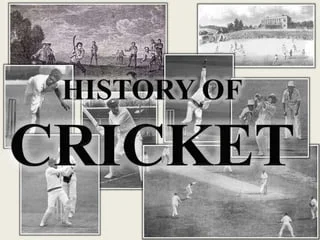Cricket, one of the world’s most popular sports today, has a rich history that stretches back centuries. It has evolved from a quaint pastime in the English countryside to a global sport watched and played by millions. Let's take a journey through the history of cricket, exploring how it began, how it developed, and how it became the international game we know today.
Early Origins
The exact origins of cricket are unclear, but historians believe the game began in the 16th century in the rural regions of southeast England, particularly in the counties of Sussex and Kent. It was initially a children’s game played on village greens with basic equipment, such as a ball made of wool and a bat resembling a club or stick.
The name "cricket" is thought to have come from the Old English word “cricc” or “cryce,” meaning a staff or crutch. By the early 17th century, cricket had grown in popularity and began to be played by adults, evolving into a more structured sport.
The Rise of Organized Cricket (18th Century)
Cricket saw significant growth in the 18th century, particularly after the English Civil War when recreational activities began to flourish again. The first known official cricket match was played in 1646, and by the early 1700s, the sport was gaining attention from the British aristocracy.
In 1744, the first set of official rules for the game was written, laying the groundwork for modern cricket. Around this time, teams started forming, and inter-county matches became popular. It was also in the 18th century that cricket became known as the "gentleman’s game," primarily played by the upper classes.
The Birth of International Cricket (19th Century)
Cricket's popularity continued to spread across England, and by the 19th century, the British Empire had introduced the game to its colonies. This led to cricket being embraced in countries like India, Australia, South Africa, and the West Indies.
The first international cricket match was played in 1844 between Canada and the United States, but it was in 1877 that the first official Test match took place. This historic game, held between England and Australia in Melbourne, is considered the start of modern international cricket. The rivalry between these two countries birthed one of the sport’s most famous competitions, The Ashes, which began in 1882 and continues to this day.
Growth and Globalization (20th Century)
The early 20th century saw the rise of international cricket, with more countries participating in Test matches. India, West Indies, New Zealand, and South Africa all became key cricketing nations by the 1930s.
The mid-20th century marked another evolution in the sport with the creation of limited-overs cricket. In 1971, the first One Day International (ODI) match was played, introducing a faster-paced, more spectator-friendly version of the game. This format helped cricket reach a broader audience and gain commercial success.
The inaugural Cricket World Cup was held in 1975 in England, establishing a global tournament that now ranks among the world’s major sporting events. Meanwhile, cricket continued to grow in regions such as the Indian subcontinent, where it became a national obsession, especially in India and Pakistan.
The Modern Era and T20 Revolution (21st Century)
Cricket entered the 21st century with a new, even shorter format—Twenty20 (T20) cricket. Introduced in 2003, T20 games last only around three hours, compared to the days-long Test matches or the full-day ODIs. This format has been a game-changer, attracting new fans with its fast pace and excitement. The first T20 World Cup was held in 2007, further boosting the sport’s popularity, particularly among younger audiences.
The Indian Premier League (IPL), founded in 2008, became one of the most successful T20 leagues globally, turning cricket into a spectacle filled with international stars, big sponsorships, and entertainment. The IPL has played a crucial role in making cricket more commercially lucrative and globally recognized.
Cricket Today
Today, cricket is played and watched by millions across Asia, Australia, Africa, the Caribbean, and beyond. Test cricket remains the sport’s most traditional and revered form, while ODIs and T20s have broadened its global appeal. The International Cricket Council (ICC) governs the sport worldwide, organizing major tournaments such as the Cricket World Cup and the T20 World Cup.
Cricket continues to evolve, with innovations in technology, rules, and formats ensuring its relevance in the modern era. Whether it’s the slow-burning drama of a Test match or the fast-paced excitement of a T20 game, cricket has grown from its humble beginnings to become one of the world’s favorite sports.
Conclusion
From village greens in England to packed stadiums around the world, cricket has come a long way. Its ability to adapt and evolve has allowed it to thrive across centuries, becoming a symbol of national pride in many countries. Whether it’s through thrilling international competitions or local matches, cricket’s unique blend of skill, strategy, and tradition continues to captivate fans across the globe.

